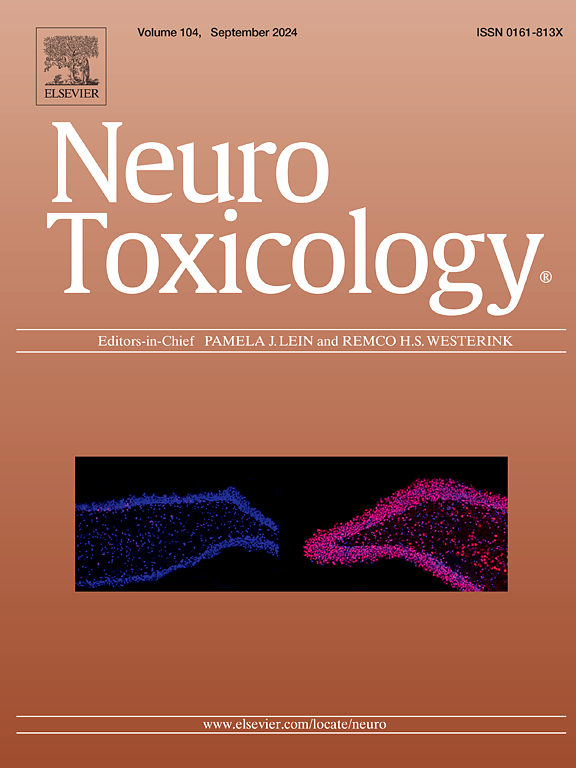Cumulative risk assessment as the pathway to public health protection for behavioral neurotoxicity
IF 3.9
3区 医学
Q2 NEUROSCIENCES
引用次数: 0
Abstract
The formulation of adverse outcome pathways (AOPs) based on high-throughput in vitro new approach methods linking biochemical/mechanistic data with an apical endpoint considered an adverse outcome (AO), is increasingly proposed to accelerate the process of risk assessment for environmental chemical exposures. While a laudable goal, this approach ignores the extensive evidence demonstrating context-dependence of neurotoxicological consequences, including behavioral toxicity of chemical exposures. Such contextual modifiers can include environmental conditions (poverty, psychosocial stress, behavioral experience/history), physiological conditions (sex, period of exposure, nutritional status, brain region, exposure parameters), and genetic background. Context dependence represents a serious omission for AOP formulation because an environmental context can alter a chemical’s molecular targets, or potentially enhance toxicity through interactions with other contextual conditions, thus leading to potential underestimation of neurological risks due to such exposures. The integrative physiological basis of AOs requires cumulative risk assessments that model environmental contexts across scales of biology, i.e., integration and testing in whole-animal models. AOPs contribute to the derivation of cumulative risk considerations regarding factors to incorporate into cumulative risk assessments by defining risk factors with shared biological targets. Epidemiological and animal model studies can provide information to prioritize interactive effects of greatest magnitude. Additionally, a focus on how a single risk factor in different physiological contexts may attribute risk across multiple neurologic conditions, rather than to a single unique condition, would provide broader public health protection. Realistic acknowledgement of context-dependence is requisite to understanding both the etiological basis of neurological diseases and disorders and to human health protection.
累积风险评估作为行为神经毒性的公共健康保护途径。
越来越多的人提出,基于高通量体外新方法,将生化/机制数据与被认为是不良结果(AO)的根尖终点联系起来,制定不良结果途径(AOPs),以加速环境化学品暴露的风险评估过程。虽然这是一个值得称赞的目标,但这种方法忽略了证明神经毒理学后果的环境依赖性的广泛证据,包括化学暴露的行为毒性。这些环境修饰因素包括环境条件(贫困、社会心理压力、行为经历/历史)、生理条件(性别、暴露期、营养状况、脑区、暴露参数)和遗传背景。上下文依赖性代表AOP表述中的一个严重遗漏,因为环境上下文可以改变化学物质的分子靶标,或者通过与其他上下文条件的相互作用潜在地增强毒性,从而导致由于这种暴露而导致的神经系统风险的潜在低估。AOs的综合生理基础需要累积风险评估,以跨生物学尺度模拟环境背景,即在全动物模型中进行整合和测试。aop通过定义具有共同生物靶点的风险因素,有助于推导有关因素的累积风险考虑因素,以纳入累积风险评估。流行病学和动物模型研究可以提供信息,确定最严重的相互作用的优先次序。此外,关注不同生理背景下的单一风险因素如何将风险归因于多种神经系统疾病,而不是单一的独特疾病,将提供更广泛的公共卫生保护。现实地认识到情境依赖性对于理解神经疾病和失调的病因学基础以及保护人类健康都是必要的。
本文章由计算机程序翻译,如有差异,请以英文原文为准。
求助全文
约1分钟内获得全文
求助全文
来源期刊

Neurotoxicology
医学-毒理学
CiteScore
6.80
自引率
5.90%
发文量
161
审稿时长
70 days
期刊介绍:
NeuroToxicology specializes in publishing the best peer-reviewed original research papers dealing with the effects of toxic substances on the nervous system of humans and experimental animals of all ages. The Journal emphasizes papers dealing with the neurotoxic effects of environmentally significant chemical hazards, manufactured drugs and naturally occurring compounds.
 求助内容:
求助内容: 应助结果提醒方式:
应助结果提醒方式:


